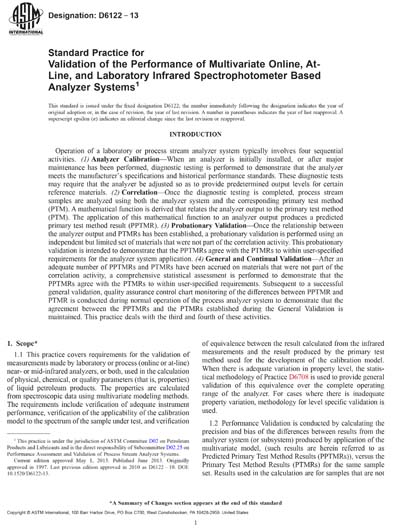Historical
ASTM D6122-13
Standard Practice for Validation of the Performance of Multivariate Online, At-Line, and Laboratory Infrared Spectrophotometer Based Analyzer Systems
1.1 This practice covers requirements for the validation of measurements made by laboratory or process (online or at-line) near- or mid-infrared analyzers, or both, used in the calculation of physical, chemical, or quality parameters (that is, properties) of liquid petroleum products. The properties are calculated from spectroscopic data using multivariate modeling methods. The requirements include verification of adequate instrument performance, verification of the applicability of the calibration model to the spectrum of the sample under test, and verification of equivalence between the result calculated from the infrared measurements and the result produced by the primary test method used for the development of the calibration model. When there is adequate variation in property level, the statistical methodology of Practice D6708 is used to provide general validation of this equivalence over the complete operating range of the analyzer. For cases where there is inadequate property variation, methodology for level specific validation is used.
1.2 Performance Validation is conducted by calculating the precision and bias of the differences between results from the analyzer system (or subsystem) produced by application of the multivariate model, (such results are herein referred to as Predicted Primary Test Method Results (PPTMRs)), versus the Primary Test Method Results (PTMRs) for the same sample set. Results used in the calculation are for samples that are not used in the development of the multivariate model. The calculated precision and bias are statistically compared to user-specified requirements for the analyzer system application.
1.2.1 For analyzers used in product release or product quality certification applications, the precision and bias requirement for the degree of agreement are typically based on the site or published precision of the Primary Test Method.
1.2.2 This practice does not describe procedures for establishing precision and bias requirements for analyzer system applications. Such requirements must be based on the criticality of the results to the intended business application and on contractual and regulatory requirements. The user must establish precision and bias requirements prior to initiating the validation procedures described herein.
Content Provider
ASTM International [astm]






